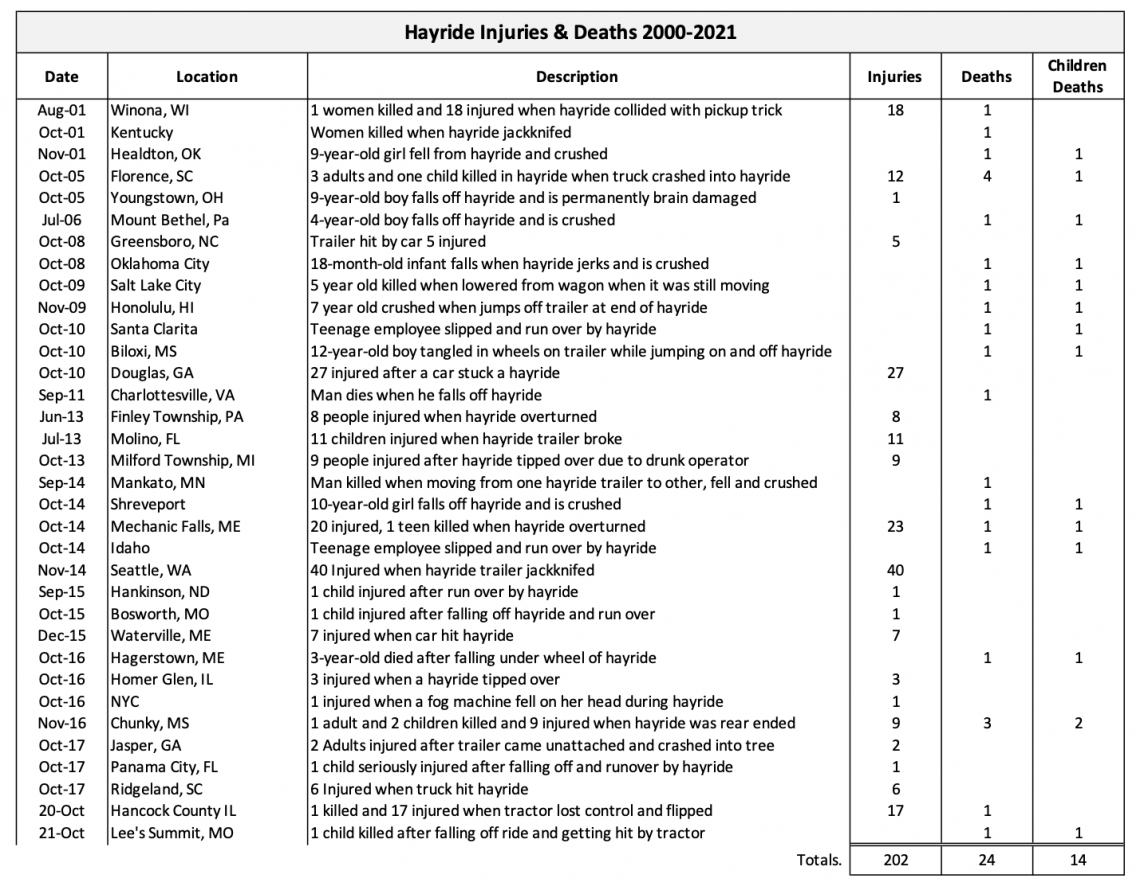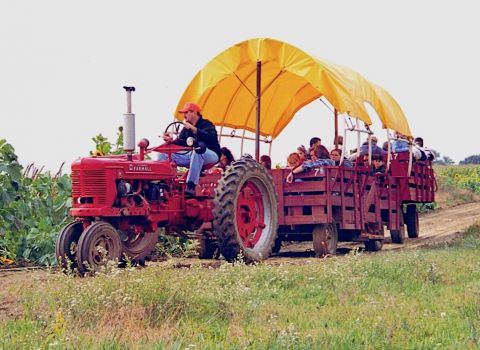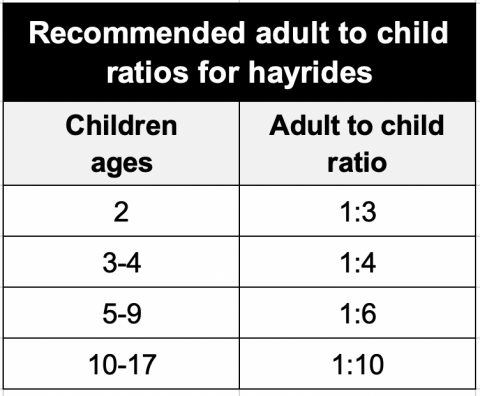
Vol. XXII, No. 4, April 2022
New hayride safety standards
Our research has found that hayride accidents in the U.S. since 2000 have resulted in at least 202 injuries and 24 deaths, 14 of which were children, one as recently as last year. Here are the details.


The American Society for Testing and Materials, known as ASTM, has developed a Standard Practice for Hayride Attractions (F3168). It applies to hayrides at amusement, entertainment, recreational, or agritourism businesses, including but not limited to family entertainment centers (FECs), camps, shopping centers, seasonal attractions, pumpkin patches, corn mazes, farms, fairs, and municipal parks. The Standard also incorporates by reference ASTM F770, Standard Practice for Ownership, Operation, Maintenance, and Inspection of Amusement Rides and Devices, with appropriate noted modifications.
The purpose of the Standard Practice for hayrides is to provide consistent standards for the operation of hayrides, including safety for riders, attendants, operators, and spectators. Although the standards are voluntary, ASTM standards often become the de facto standard by which liability is determined in court lawsuits when hayride accidents happen.
The Standard covers many aspects of hayrides, including operations, safety, design, maintenance, and documentation, including such things as:
- The need for a communication system
- Needed weight, capacity, and traction for the tractor or tow vehicle
- Tamper-proof locking hitches
- Safety chains
- Loading and unloading
- Written operator procedures
- An inspection program
- A daily documented preopening inspection
- Daily inspection and grooming of the trail/route
- Training programs
- Rider education
- Incident reports
- Educational signage
- Announcement of appropriate rules to riders
The Standard's appendix has many good examples of different needed checklists, rules, and reports.
While the Standard covers many important aspects of operating hayrides, they fall short of many needed safety standards. For example, they require a bulkhead at the head of hay wagons but fail to require sides and rear barriers. Our CEO has been an expert witness in two cases where children were injured on a hayride. One injury was due to the hay wagon lacking side barriers.
They also fail to address things like fencing offloading areas, never driving through areas accessible to the public, having a designated wagon loader, and many other standards to address safety.
In 2019, we published an article, Essentials of hayride safety, republished by the NAFDMA International Agritourism Association. Here are some of our recommendations from that article that we feel ASTM failed to include for safe hayride operations:
- The hayride route should have non-climbable barricade-type fencing along its route wherever it is in or near areas where visitors will be so there is no possibility of anyone, especially children, wandering into the path of the hayride. The fencing should have gates operated only by the loading/unloading staff at the loading and unloading areas. The hayride path should NEVER cross or travel through any areas that the public has access to.
- Separate unloading and loading areas. To speed loading, the loading area can have a corral fenced area where the number of visitors the wagon ride can hold is pre-counted into.

- For adequate traction and braking, the tractor pulling the hayride must weigh more than the gross weight of the wagon it pulls when full of people.
- The hay wagon must have railings and seating. Enclosure railings should be designed to prevent children from crawling through or climbing the railings. The front railing must be adequately tall and sturdy to prevent anyone from falling forward out of the wagon and being run over [the ASTM Standards only require the bulkhead to be 18 "tall, which is not high enough. It should be at least double that height, 36" or more]. The loading opening on the wagon should have a gate or enclosure that is kept shut other than when loading or unloading.
- All wagons should have a tour guide riding in the wagon with a two-way radio to communicate with the tractor driver. Tractor noise prevents a driver from hearing anything shouted from the wagon if there is a problem.
- Tractors should have rearview mirrors that give a full view of the wagon.
- There should be well-organized loading and unloading procedures.
- Only after the tractor stops in the unloading area, is put in neutral, and the brake engaged should the unloading staff open the wagon gate and assist people off.
- Once a wagon is unloaded, the unloading staff should close the barricade exiting gate, the wagon should be inspected for lost items, the tire inflation on the wagons and tractor should be eyeballed, the area around and under the wagon should be inspected to make sure there are no people or children, and only then should the tractor driver be signaled to proceed to the loading area.
- The barricade gate at the loading area should not be opened until the tractor is at a complete stop, put in neutral and the brakes engaged.
- Once the wagon is loaded, the barricade loading gate should be closed, the wagon gate should be closed, safety instructions should be recited to the riders, riders should be checked to make sure all are seated, the area around and under the wagon inspected to make sure there are no people or children, the pins and safety chains on the wagons checked and only then should the tractor driver be signaled to proceed.
- Ideally, communication between the loading and unloading staff and the driver should be via two-way radio communication. Otherwise, the driver's go-signal should be visual, crystal clear, and not mistakable.
- Public road travel should be avoided. If absolutely necessary, there should be escort vehicles with proper safety lighting at the lead and following the wagon. In 1989 in New Brunswick, Canada, 13 wagon riders died, and 45 were injured when a logging trailer crashed into a hayride. In 2016 in Chucky, Mississippi, three people were killed when a pickup truck rear-ended a hay wagon traveling on a public road.
- Due to the hazardous nature of hayrides, children's field trip hayrides should have higher adult-to-child ratios than in the classroom. The following are recommended:

Hayrides are a great fun attraction for visitors. Just make sure you take the time and effort to operate yours safely.


